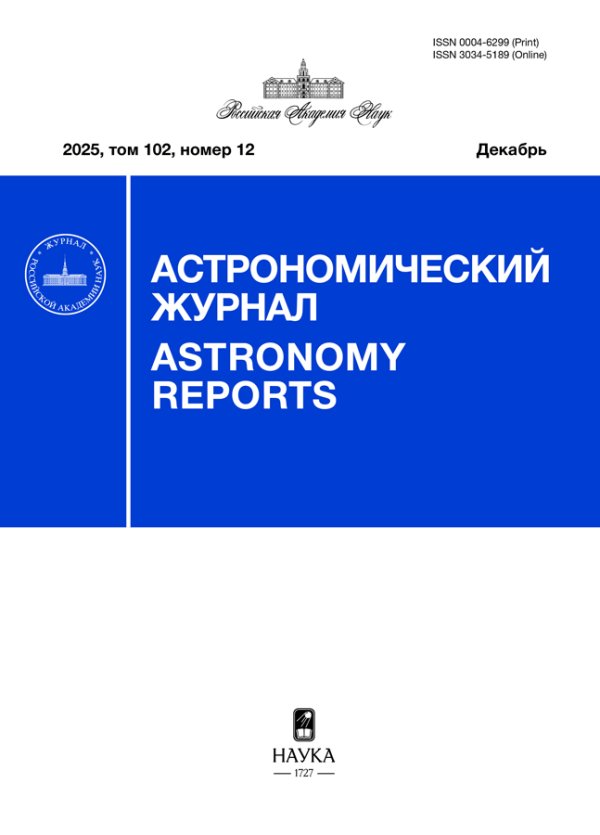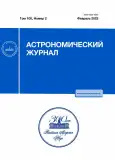Vol 100, No 2 (2023)
Articles
Eliminating the Hubble Tension in the Presence of the Interconnection between Dark Energy and Matter in the Modern Universe
Abstract
It is accepted in modern cosmology that the scalar field responsible for the inflationary stage of the early Universe is completely transformed into matter. It is assumed that the accelerated expansion is currently driven by dark energy (DE), which is likely determined by Einstein’s cosmological constant, unrelated to the scalar field responsible for inflation. We consider a cosmological model in which DE can currently have two components, one of which is Einstein’s constant (Λ) and the other, smaller dark energy variable component DEV (ΛV), is associated with the remnant of the scalar field that caused inflation after the main part of the scalar field has turned into matter. We consider only the stages of evolution of the Universe after recombination (z<=1100), where dark matter (DM) is the predominant component of matter. It is assumed that the transformation of the scalar field into matter continues at the present time and is accompanied by the reverse process of the transformation of DM into a scalar field. The interconnection between DM and DEV, which leads to a linear relationship between the energy densities of these components after recombination ρDM=αρDEV, is considered. Variants with a dependence of the coefficient α(z) on the redshift z are also considered. One of the problems that have arisen in modern cosmology, called Hubble Tension (HT), is the discrepancy between the present values of the Hubble constant (H0) measured from observations of the Universe at small redshifts (z≲1) and the values found from fluctuations of the cosmic microwave background in the Universe at large redshifts (z≈1100). In the model under consideration, this discrepancy can be explained by the deviation of the existing cosmological model from the conventional Λ cold dark matter (CDM) model of the flat Universe by the action of the additional dark energy component DEV at the stages after recombination. Within this extended model, we consider various α(z) functions that can eliminate the HT. To maintain the ratio of DEV and DM energy densities close to constant over the interval 0⩽z≲1100, it is necessary to assume the existence of a wide spectrum of dark matter particle masses.
 133-143
133-143


On the Possibility of Observing Nitric Oxide on Terrestrial Exoplanets Using the WSO-UV Observatory
Abstract
It is generally believed that the presence of a N2−O2-dominant atmosphere is an indication of biological and geological activity on terrestrial exoplanets that are in the habitable region. One of indicators of such an atmosphere is the nitric oxide (NO) molecule. It is known from satellite observations of the Earth’s atmosphere that the brightest nitric oxide band in the ultraviolet range is the γ band (203–248 nm). Space telescopes such as the existing HST and the upcoming WSO-UV can observe in this spectral range. The paper presents estimates of the luminosity of various exoplanets in the NO γ band. It has been established that the detection of NO emission in the γ band in the atmospheres of typical terrestrial exoplanets is possible using the spectrographs of the WSO-UV observatory within a reasonable observational time (5 WSO-UV orbits or 120 observation hours).
 144-165
144-165


Neutrino Spectra of Magneto-Rotational Supernovae and Observations Using Large-Volume Telescopes
Abstract
The dynamics of neutrinos in hot and dense magnetized matter, corresponding to a magneto-rotational explosion of supernovae, is considered. It is shown that the effective collisions of neutrinos in a magnetized nucleon gas, due to the Gamow–Teller component of the neutral current, change from exo- to endo-energetic scattering, when the neutrino energy becomes approximately four times higher than the temperature of the substance. Correspondingly, the energy transfer cross section in the neutrino kinetics changes from positive to negative values under these conditions. For realistic parameters of supernovae, the considered effects lead to an increase in the hardness of the neutrino spectra. The possibilities of detecting supernova neutrinos by large-volume observatories KM3NeT and Baikal-GVD are discussed.
 166-172
166-172


Effect of the Eccentricity of the Planet’s Orbit on the Limb Darkening Coefficients of the Eclipsed Star
Abstract
It is shown that the introduction of a small orbital eccentricity into the model of a binary system with an exoplanet, which is allowed by errors in determining the radial velocities of the eclipsed star, makes possible to significantly reduce and even eliminate the difference in the wavelength dependences between the observed and theoretical values of the limb darkening coefficients of the star HD 209458.
 173-185
173-185


On the Problems of Detecting Fast Radio Bursts with the LPA LPI
Abstract
We present a verification of fast radio bursts (FRBs) previously published by V.A. Fedorova and A.E. Rodin. These FRBs were found in the monitoring data with the Large Phased Array (LPA) radio telescope using a search algorithm based on data convolution with a scattered pulse pattern. The same 6-channel data (channel width 415 kHz) were used for verification, in which FRBs were found with dispersion measures of 247, 570, and 1767 pc/cm3. An additional verification of the published FRBs was also carried out in 32‑channel data (channel width 78 kHz). We can not confirm any of the published FRBs on the signal-to-noise ratios claimed in the original paper. The main errors are caused by incorrect determination of the baseline and incorrect estimation of noise standard deviations.
 186-195
186-195


Search for Pulsars in an Area with Coordinates 3h < α < 4h and +21° < δ < +42°
Abstract
The search for pulsars outside the plane of the galaxy in an area of 300 sq. deg. was carried out with the LPA LPI antenna at 111 MHz, with a sensitivity 5 to 10 times better than that of previous surveys. The search was performed in the summed power spectra. With an accumulation time equivalent to 100 hours of continuous observations for each point of the area, 5 known pulsars were found with a signal-to-noise ratio (S/N) from 20 to 1300 in the first harmonic of the spectrum. Average profiles are obtained for the detected pulsars. Estimates are given for the peak and integrated flux densities of the found pulsars for individual sessions and for power spectra summed over 5.5 years, using the developed method based on measurements of harmonic heights in the power spectrum. No new pulsars were found in the area. Apparently, when searching for pulsars in the area, we approached the lower limit of the luminosity of second pulsars. The survey completeness is at the level of 0.5 mJy.
 196-205
196-205


On the Evolution of Angles between the Magnetic Moment and the Axis of Rotation in Radio Pulsars
Abstract
Three methods were used to calculate the angles β between the magnetic moment and the axis of rotation of central neutron stars for 307 known radio pulsars. There is no explicit statistical dependence of the calculated angles β on the kinematic age of pulsars. It follows from this that either the indicated angle does not change noticeably with the age of the pulsar, or pulsars are born with an arbitrary inclination angle.
 206-218
206-218












